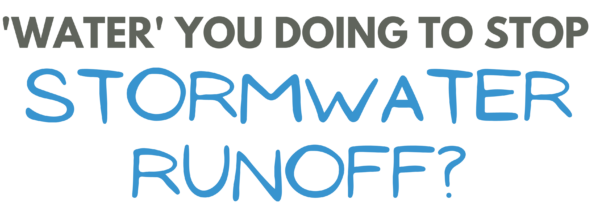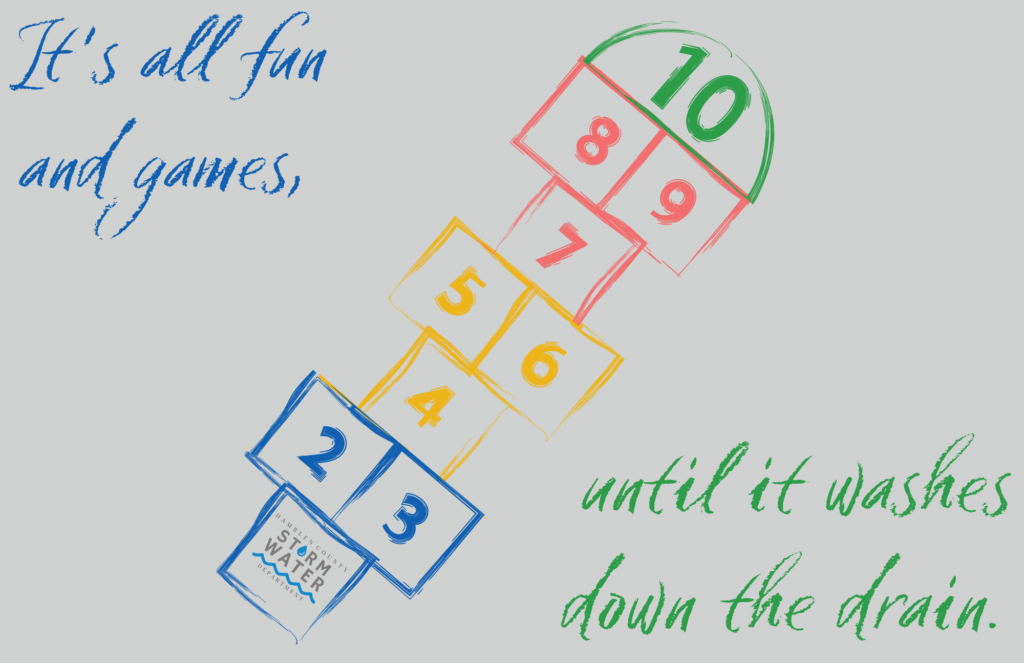- Utilize Car Washes – When you wash your car at home, the soapy/dirty water can flow into storm drains and into our waterways. Car washes have mechanisms in place to keep the water, soap, and other cleaning chemicals from reaching storm drains.
- Pick Up After Your Pets – Not only is it good, neighborly courtesy, but picking up your pet’s waste keeps their feces and all the bacteria it contains from ending up in our water ways! We know you love your pet, but no one wants to drink that!
- Direct Your Downspouts – Make sure your downspouts are pointed toward grassy areas or a garden, rather than toward your driveway/road. The ground absorbs the water, which keeps the grass and plants healthy, and it prevents the water from streaming down the roads, reducing the risk of flooding and the risk of the water picking up debris as it travels toward storm drains.
- Septic Tank Upkeep – By being active and having regular septic tank inspections (every three years), you can do your part to prevent sewage backup in your house/yard.
- Store and Use Chemicals Wisely – Make sure that you do not store chemicals such as oil, paint, gasoline, cleaning supplies, weed killers, etc. outside.
- Vehicle Maintenance – Be prudent in the maintenance in your vehicles. Regular tuning and checkups can prevent oil leaks and spills.
- Pesticides – Use weed killer and other lawn care chemicals wisely. Check the weather prior to use, so that rain doesn’t immediately wash away your work and send the chemicals down storm drains.
- Plant Trees – Trees are a great way to help reduce the amount of runoff from your yard.
- Use Rain Barrels – Rain Barrels are a great, easy, and inexpensive way to help reduce the amount of runoff from your yard. To learn more about the benefits of using a rain barrel, check out our Rain Barrel Guide!
- Install a Rain Garden – A rain garden utilizes the native plants of the area to help reduce the flow of runoff. By planting plants with various absorption rates (how quickly a plant absorbs water), it allows the garden to hold the water while the plants absorb it, which also helps reduce the flow of runoff to a storm drain.
- Properly Dispose of Chlorinated Water – Never dump pool water into the yard or street.
- Proper Storage of Chemicals – Hazardous materials not only pose a risk to streams, but are dangerous to human beings. Storing materials properly, especially hazardous materials, is a very useful way to protect stormwater and those who work in municipal facilities. Proper storage prevents spills or at least contains any spills that may occur. Make sure to regularly inspect chemicals for leaks and expiration dates. Keep chemicals stored in a cool, dry place, and keep them out of high traffic areas. Label all containers and, where possible, invest in secondary containment to mitigate any leaks or spills.
- Refrain from Illicit Discharge and Illegal Dumping – If there are any spills, especially in an outdoor area, notify your supervisor immediately. You should also inform your local stormwater contact person. Have absorption kits as part of your company’s safety procedures to aid in the swift clean up of any spilled materials. Contact waste management for guidance on how to properly dispose of chemicals.
- Training – Make sure to train all new employees, and hold annual reviews for all staff on company procedures for chemical spills, garbage maintenance, and other safety procedures.
- Landscaping – Plant trees, utilize rain barrels or rain barrels if possible.
- Garbage Maintenance – Do not store garbage cans near storm drains, make sure all garbage cans have a lid that can be secured, and never dump loose garbage into a garbage can. Try to recycle as much as you’re able as well.
- Proper Disposal of Products/Chemicals – Contact waste management for guidance on how to properly dispose of chemicals. NEVER pour chemicals or other materials down a storm drain.
- Vehicle Maintenance – Regularly inspect all vehicles used on the premises for leaks.
- Plan Ahead – Be aware of the local Stormwater Regulations and Best Management Practices. Contact our office prior to any construction to discuss options and to schedule a Pre-Construction Meeting.
- Obtain All Required Permits and Documentation – Approval from the Tennessee Department of Environment Conservation (TDEC) will be required. A Notice of Intent (NOI) must be submitted to the state and approval granted prior to the issuance of any local permits. Check with the state to see if an ARAP or Construction General Permit is also needed.
- Prepare Your SWPPP – The Stormwater Pollution Prevention Plan (SWPPP) is a required document that local and state inspectors will need to access on the construction site. This document will list your Best Management Practices for reducing/preventing stormwater runoff from your construction site. An engineer with Level II Stormwater Training is required to create this document.
- Communication is Key! – Make sure to keep in touch with your local stormwater office for any additional requirements that may be needed.
- Buffers – Be aware of any streams, lakes, or other bodies of water close to your construction site and make sure that all buffer requirements are met.
- Graded Areas – All graded areas must have temporary or permanent cover if the area is to remain untouched for more than 14 days.
- Install Stormwater Protection Measures – Silt fences, gravel, blown straw, wood chips, chemical anchoring, and netting are all acceptable methods to help prevent stormwater runoff from the site.
- Have a Designated Cleaning Area for Vehicles – Construction usually generates mud. That mud gets on the construction vehicles. Designate a place on your construction site that will not drain onto a road or into a storm drain to wash your vehicles. This will prevent mud and other unsanitary materials from being tracked onto the main roads and ultimately washed into storm drains.
- Supply Sufficient Waste Bins for Trash – Encourage workers to dispose of their trash in the appropriate bins to reduce the amount of litter and debris on the ground. Keep plenty of bins readily accessible and reward cleanliness!
- Train Employees on the Importance of Maintaining A Clean Working Environment – Train employees on the importance of keeping the construction site clean. This will reduce the potential for accidents and keep the debris from getting into our storm drains.
- Yard Waste – Never dump yard waste along creek banks or into storm drains. Blow leaves and grass clippings back into yards or collect them in yard waste bags.
- Pesticide Management – Avoid applying fertilizers and pesticides near streams, lakes, or ponds. Use slow-release fertilizers whenever possible to minimize leeching.
- Don’t Over-Fertilize – The plants can only absorb so much at once, and an excess of chemicals or fertilizer is only going to be swept away with the next rain.
- Suggest Rain Gardens – Discuss with your clients the benefits of a rain garden. Not only can they be a beautiful addition to a home, but they are good for the environment and help reduce the flow of runoff into storm drains!
- Install Water Bags – These water bags will help catch excess water and allow the trees to absorb it over time, preventing the water from flowing into a storm drain and picking up the debris along the way.
Resources on How to Prevent Stormwater Runoff
Please feel free to print these off and share at your organization or business! Send any pictures you take to us at stormwater@co.hamblen.tn.us so we can admire your creativity!
Stormwater Pollution Prevention for Landscapers
Stormwater Best Management Practices for Municipal Operations – Pollution Prevention
Stormwater Resources for Kids
Video: Keeping Our Water Clean! – SciShow Kids
Test Your Water Sense Online Game – EPA
Stormwater Bingo Sheet and Vocab List – Clean Water Education Partnership
Find Your Water-Saver Superhero Name! – wateruseitwisely.com
Wayne Drop’s Crossword Puzzle – wateruseitwisely.com


